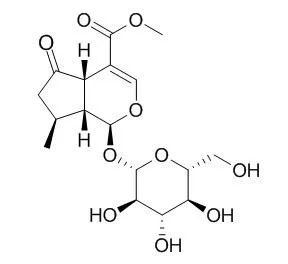| Description: |
Verbenalin has been reported to exhibit uterine stimulant activity and demonstrated cardioprotection against experimental myocardial ischemic injury and cerebral ischemia injury. Cornin induces angiogenesis in vitro via a programmed PI3K/Akt/eNOS/VEGF signaling axis, it also has antimitotic action on dividing cell. |
| Targets: |
PI3K | Akt | NOS | VEGFR | ROS |
| In vitro: |
| Acta Med Okayama. 1977 Jun;31(3):203-9. | | Purification and some characteristics of liver cytosol cornin, an antimitotic substance from rat liver cytosol.[Pubmed: 144419] | Further purification and characterization are reported on rat cytosol Cornin (RLCC), an antimitotic substance.
METHODS AND RESULTS:
Fraction I (purified RLCC) was purified more than 10-fold from crude RLCC with Sephadex G-50 column chromatography and showed a remarkable inhibitory effect on division of inseminated sea urchin eggs and mouse fibroblast cells. Fraction I was observed as one spot, and the molecular weight was estimated to be about 25,000 by thin layer gel filtration. Fraction I contained protein (92%) and RNA (8%), but the antimitotic activity was scarcely affected by treatment by pancreatic RNase. The protein of Fraction I was separated into two bands by SDS-polyacrylamide gel electrophoresis, and the molecular weight was estimated as 10,000 and 15,000, respectively.
CONCLUSIONS:
The 50% inhibition dose of Fraction I on the first division of inseminated sea urchin eggs and on proliferation of mouse L cells was about 2.5 X 10(-5) g/ml and 5 X 10(-4) g/ml, respectively. The yield of fraction I was about 35 mg from 100 g rat liver. | | Acta Medicinae Okayama, 1965, 19(1):11-8. | | Antimitotic action of cornin as a biologically active polypeptide. I. Biochemical properties of cornin.[Reference: WebLink] | | Antimitotic action of Cornin as a biologically active polypeptide. I. Biochemical properties of Cornin. |
|
| In vivo: |
| Phytother Res. 2010 Apr;24(4):547-52. | | Cornin ameliorates cerebral infarction in rats by antioxidant action and stabilization of mitochondrial function.[Pubmed: 20041427] | This study was conducted to investigate the efficacy of Cornin, an iridoid glycoside, in an experimental cerebral ischemia induced by middle cerebral artery occlusion (MCAO) and reperfusion (I/R), and to elucidate the potential mechanism.
METHODS AND RESULTS:
Adult male Sprague-Dawley rats were subjected to MCAO for 1 h, then reperfusion for 23 h. Behavioral tests were used to evaluate the damage to central nervous system. The cerebral infarct volume and histopathological damage were assessed to evaluate the brain pathophysiological changes. Spectrophotometric assay methods were used to determine the activities of superoxide dismutase (SOD) and glutathione-peroxidase (GPx). Contents of malondialdehyde (MDA), the generation of reactive oxygen species (ROS) as well as respiratory control ratio and respiratory enzymes of the brain mitochondria were also determined. The results showed that Cornin significantly decreased neurological deficit scores, and reduced cerebral infarct volume and degenerative neurons. Meanwhile, Cornin significantly increased the brain ATP content, improved mitochondrial energy metabolism, inhibited the elevation of MDA content and ROS generation, and attenuated the decrease of SOD and GPx activities in brain mitochondria.
CONCLUSIONS:
These findings indicate that Cornin has protective potential against cerebral ischemia injury and its protective effects may be due to amelioration of cerebral mitochondrial function and its antioxidant property. | | Braz J Med Biol Res. 2016 Feb;49(2):e5039. | | Cardioprotection against experimental myocardial ischemic injury using cornin.[Pubmed: 26871971 ] | Phosphorylated-cyclic adenosine monophosphate response element-binding protein (Phospho-CREB) has an important role in the pathogenesis of myocardial ischemia. We isolated the iridoid glycoside Cornin from the fruit of Verbena officinalis L, investigated its effects against myocardial ischemia and reperfusion (I/R) injury in vivo, and elucidated its potential mechanism in vitro.
METHODS AND RESULTS:
Effects of Cornin on cell viability, as well as expression of phospho-CREB and phospho-Akt in hypoxic H9c2 cells in vitro, and myocardial I/R injury in vivo, were investigated. Cornin attenuated hypoxia-induced cytotoxicity significantly in H9c2 cells in a concentration-dependent manner. Treatment of H9c2 cells with Cornin (10 µM) blocked the reduction of expression of phospho-CREB and phospho-Akt in a hypoxic condition. Treatment of rats with Cornin (30 mg/kg, iv) protected them from myocardial I/R injury as indicated by a decrease in infarct volume, improvement in hemodynamics, and reduction of severity of myocardial damage. Cornin treatment also attenuated the reduction of expression of phospho-CREB and phospho-Akt in ischemic myocardial tissue.
CONCLUSIONS:
These data suggest that Cornin exerts protective effects due to an increase in expression of phospho-CREB and phospho-Akt. |
|






 Cell. 2018 Jan 11;172(1-2):249-261.e12. doi: 10.1016/j.cell.2017.12.019.IF=36.216(2019)
Cell. 2018 Jan 11;172(1-2):249-261.e12. doi: 10.1016/j.cell.2017.12.019.IF=36.216(2019) Cell Metab. 2020 Mar 3;31(3):534-548.e5. doi: 10.1016/j.cmet.2020.01.002.IF=22.415(2019)
Cell Metab. 2020 Mar 3;31(3):534-548.e5. doi: 10.1016/j.cmet.2020.01.002.IF=22.415(2019) Mol Cell. 2017 Nov 16;68(4):673-685.e6. doi: 10.1016/j.molcel.2017.10.022.IF=14.548(2019)
Mol Cell. 2017 Nov 16;68(4):673-685.e6. doi: 10.1016/j.molcel.2017.10.022.IF=14.548(2019)